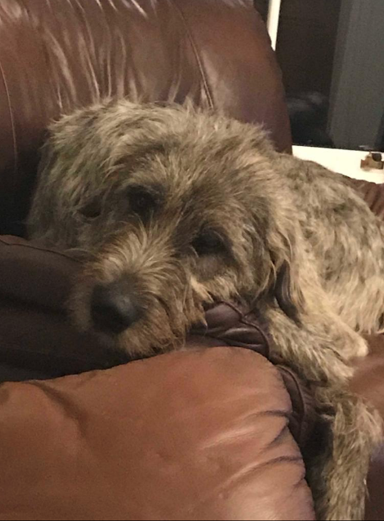Let your dog help lower your anxiety
May 2020
Today was the day I felt the anxiety rise in me. It had been three weeks since I had gone out to work and the walls were closing in. I always believed that my busy routine was a form of therapy for me, but this was proof. I needed my busy schedule. I missed my friends and talking to actual people. I missed wearing shoes. Social distancing and lockdown central were taking their toll on my physical and mental health. With no end in sight to the COVID19 nightmare, I felt the panic rise.
It was then I noticed the gaze of a pair of big brown eyes. Beautiful brown eyes. They were staring at me unphased. Then came a heavy slap of a paw on my lap. My Irish wolfhound “Mac” was having none of my self-pity. His face was so handsome. If dogs can smile, I’m sure he was. If dogs could speak, I’m sure he was saying “lady, what’s your problem?”. It dawned on me then that he was just what I needed. In fact, I started to think about the contribution dogs make to our lives, and in particular the contribution they are making to people all over the world in lockdown right now, people who are alone, or scared, or sad.
For years researchers all over the world have been documenting the valuable contribution that interacting with dogs can play in improving our physical and mental health. From lowering blood pressure to reducing stress, evidence abounds that owning a dog is good for you. The emotional and psychological stress that we are going through right now should not be underestimated. These furry companions in our own homes may hold the key to reducing our anxiety levels and helping us get through the depravation of social contact. The physical closeness and simple action of stroking a dog have been shown to release the hormones oxytocin and dopamine which promote bonding and positive emotions in people. The natural social nature of dogs makes them ideal companions in this time of separation and isolation.
So, what is it about dogs? Are they really man’s best friend? The truth is they have always been man’s best friend, since the time of the hunter-gatherer and the wild grey wolf. Dogs were the very first animals to be domesticated by man. Approximately 15,000 years ago the domestic dog as we know him genetically separated from the predecessor of wolf species we know today, and man began to selectively breed for the companions we now know.
It is no surprise that the dog was the first animal to be domesticated, long before our agricultural animals. Wolves and man coexisted for centuries, gradually forming a relationship of mutual trust and loyalty, a sort of ancient supply and confidence arrangement. Wolves provided help with herding and hunting, a source of food, an alarm system, and eventually companionship for their human partners. Humans in return provided protection from other predators, shelter, and a reliable food source for their canine companions. This worked well because wolves and humans have fundamental similarities. We are both social creatures. We live in groups, or families, with adult guardians who guide the activities of the young. Gradually dogs were selectively bred for tameness. The most tame and sociable pups were kept for breeding. Dogs that communicated and interacted best with humans were kept and bred, and so through generations, the dog in your home who “nearly speaks to you” through his body gestures, facial expressions, ear and tail carriage and vocalisations came to be.
So now, looking into those beautiful brown eyes, I no longer feel anxiety. I feel calm and I realise that this too will pass. I put my face against his big smelly head, and I wonder if our hunter-gatherer ancestors actually realised the benefits that they were giving to humankind all those thousands of years ago.
